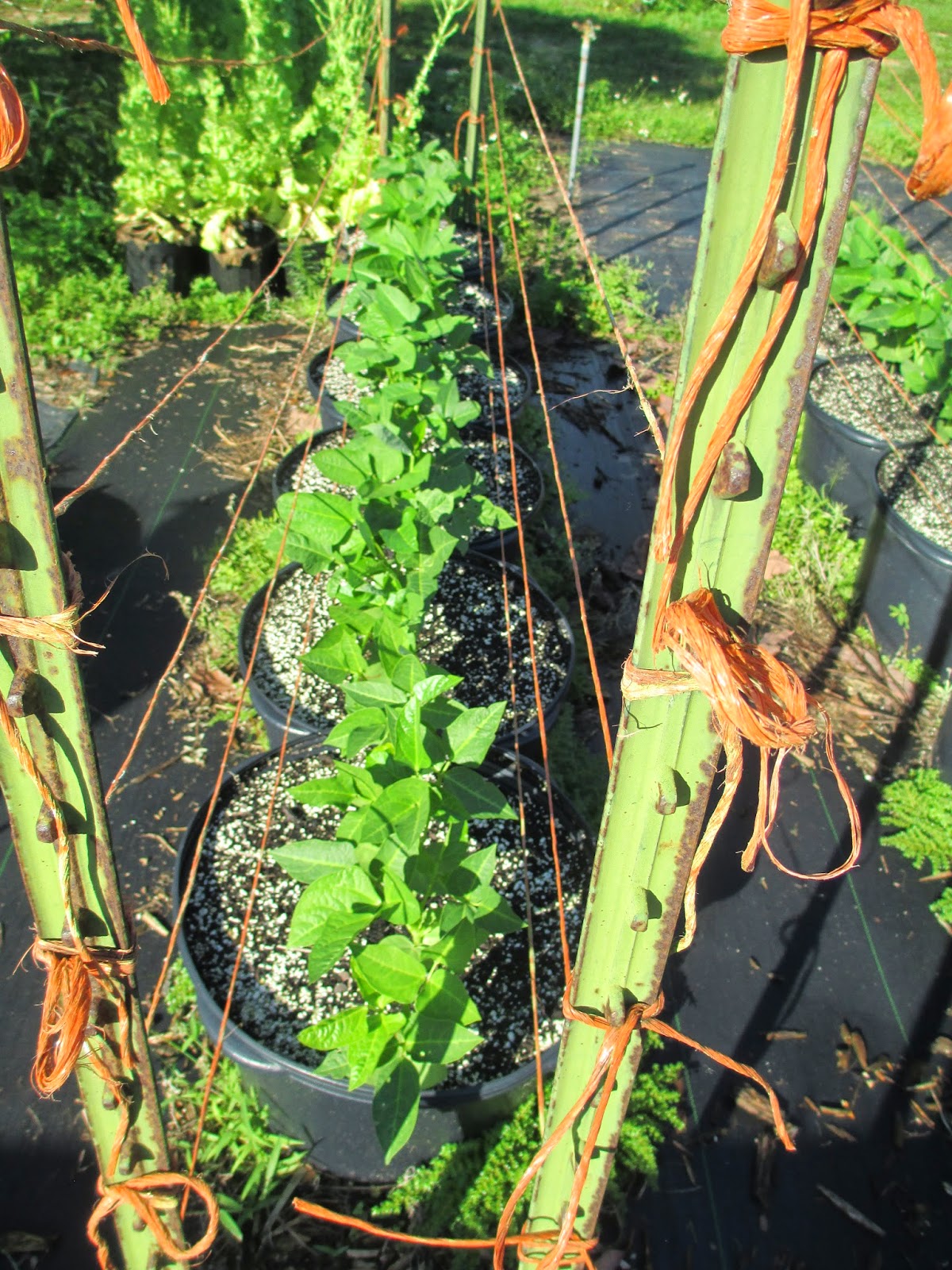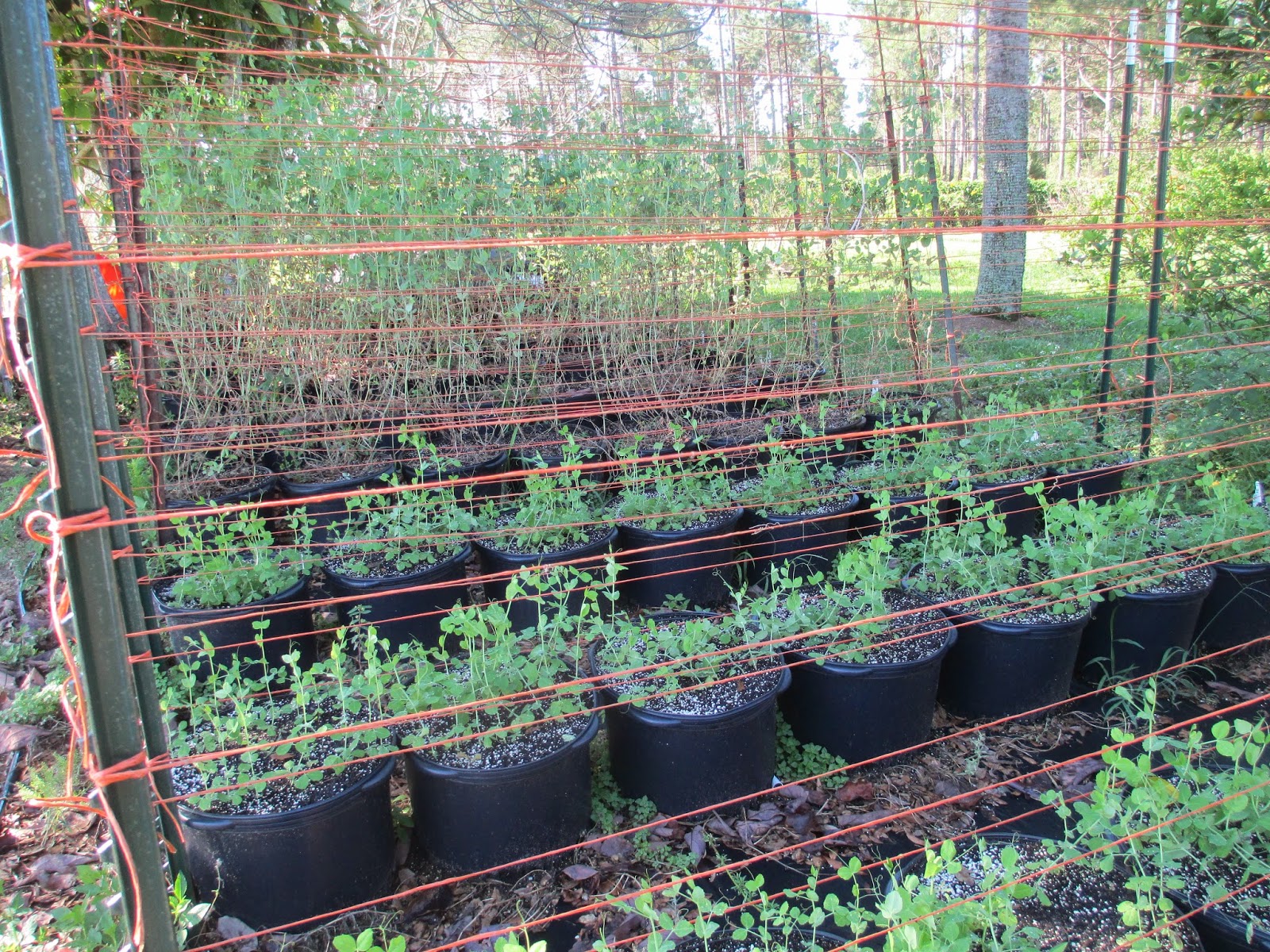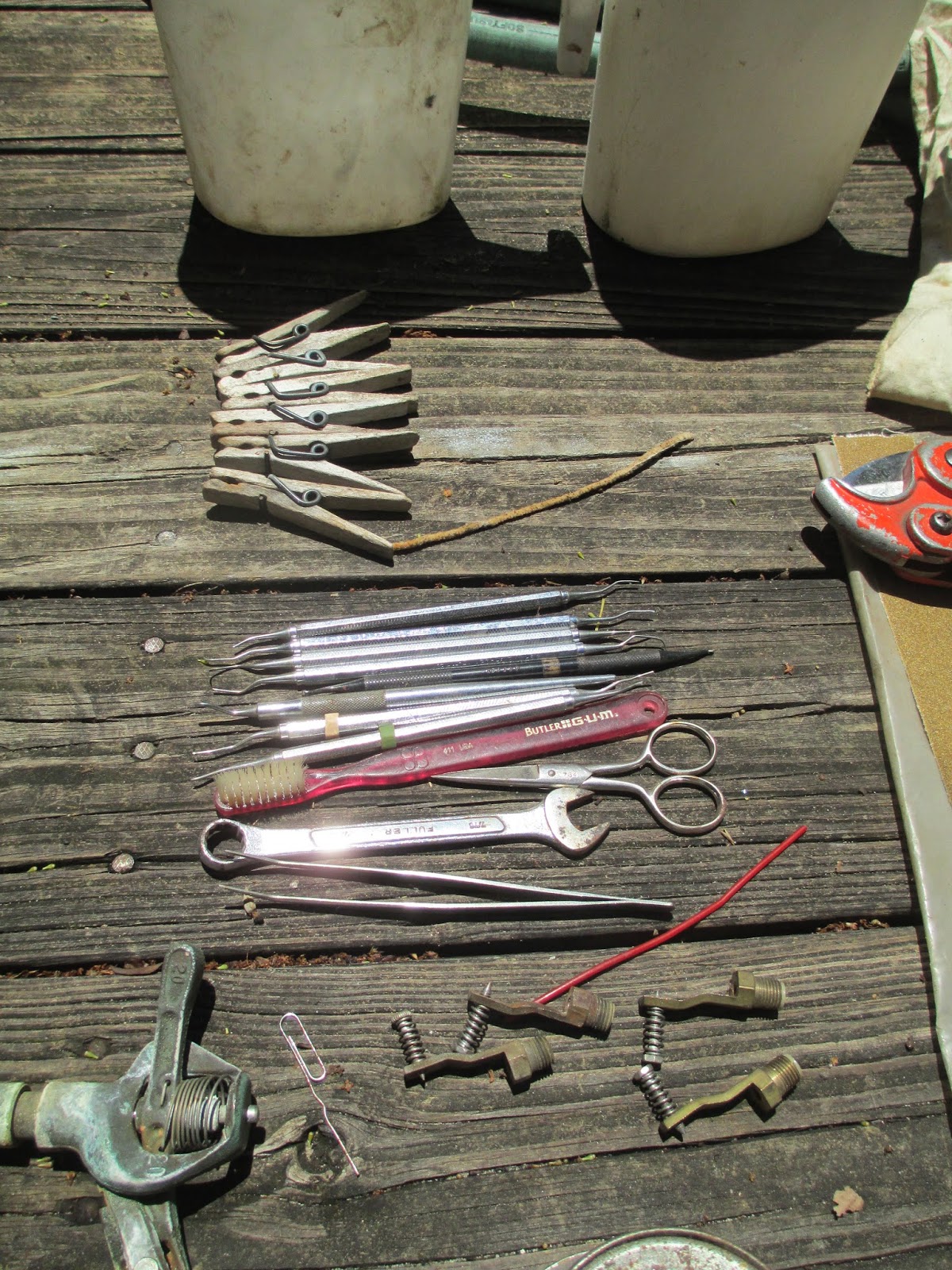Welcome to
Farm School.
This is our year-long series
focused on this newbie's quest to become a farmer.
My garden coach, Lynn, and his lovely wife Faye,
have been generous enough to nurture my ambition.
While most of the country is just gearing up for spring planting,
we're getting ready to focus on growing a few specific crops for summer.
We start each session with a tour of the garden,
to see what's progressing, what's not,
and what needs to be done.
The arugula is making progress
and has been picked for a few customers.
Aside from the farmer's market venue,
some folks come right to the farm for their orders.
The Red Salad Bowl variety of lettuce is still doing fine
after being transplanted a couple of weeks ago.
Lynn said it held up to the heavy rains we had last week.
I sure hope being in the shade helps them make it to harvest,
as lettuce is not a summer crop here.
The New Zealand spinach crop just keeps on coming.
It's nice to have it as a salad fixing,
as our lettuce has a way to go.
It can also be eaten cooked, as with conventional spinach.
The leek were banked last week
and are still enjoying time in the sunshine.
Should the high temperatures cause them any distress,
they will be relocated to a shadier area.
The black-eyed peas are still doing well
and we are looking forward to watching their growth habits.
And of course, the tasting is the reward!
The remaining crops in Peaville are still producing.
The last planting (in the first two rows here) looks healthy,
so we hope to be able to harvest for a few more weeks.
Okra is a summer staple here,
as it doesn't mind the heat one bit.
Once plants get a bit of size on them,
the worry about pests is negligent.
I had never eaten okra until last year.
When Faye & Lynn offered me pickled okra,
I was hooked!
The Red Annapolis has gone to seed.
Perty flowers, no?
That's the end of the lettuce crop
until the new starts get growing.
Fingers crossed, here!
Tomato Town is having some disease issues,
but amazingly, is producing a surprising amount of fruit.
Lynn grows the Celebrity variety of tomatoes.
They are sweet, juicy and oh-so-flavorful.
Color is starting to show on a host of these luscious bad boys.
Many are suffering from splits.
They still taste good, so I cut around the bad parts
and use them to make homemade gravy.
I'll be savoring a grilled cheese and tomato sandwich real soon.
And I was absolutely blown away by the sheer volume of
Sweet Millions cascading from the cherry tomato plants.
Each crop is just bursting with wee green globes of goodness.
They look more like a cluster of grapes,
and are almost as sweet.
Even Lynn is astounded by the massive mountain of Millions this season.
I sure wish you could just reach in and grab this.
It was my pleasure to avail myself of Lynn's invitation to sample one.
So much flavor in such a pint-sized package.
We got busy with the task at hand.
This project has been on Lynn's to-do list for quite a while.
It was our goal to plant several of these gorgeous pomegranate trees.
Lynn had prepared the sites earlier in the week
and gathered all the tools we would need for this undertaking.
He calls this his RainBird tool kit.
It contains everything needed for repairing this type of sprinkler.
We'll show you what's inside later in the post.
A little Lynngenuity here.
He uses clothespins to keep the water from soaking us while we work.
Don't cha just love clothespins?
We used a post-hole digger to create the sized hole we needed.
Then we placed the pot with the tree in it inside the hole
to check for depth.
After this first planting, we used the same pot for the remaining holes.
After placing the tree in the hole,
we watered it in well.
It's important to water on the inside rim of the hole,
rather than the outside of the root ball,
so that the root ball can stay as intact as possible.
Lynn purchased these collars back when he was a citrus grower.
They do a great job of keeping the water in near the roots,
where it will do the most good.
We filled in around the outside of the collar with the dirt that had been removed.
This gives extra support to the collar.
The key to successful tree planting,
is to eliminate air bubbles.
Sometimes the soil (or sand) needs to be manipulated
so that the air pockets are eradicated.
We found a couple of saplings while we were transplanting.
I asked Lynn about trimming the roots.
As this lil' guy has so few, the roots are left intact,
so that the tree has the best chance for survival.
They were given new homes in smaller pots
and will no doubt be given lots of tender loving care.
Here's what Lynn keeps in his RainBird kit.
An array of tools and gizmos to keep his sprinklers
in good working order.
Some of the items are the clothespins we showed earlier,
pipe cleaners, wrenches and dental tools.
When a sprinkler isn't doing its job,
it gets whacked on the top with this fierce beast.
It cleans out some of the crud clogging the sprayer.
Through time and experience,
and a lot of resourcefulness,
Lynn has found what works best.
It's part of what he calls his "adaptive nature".
I'm just a small farmer in training.
But Farm School always helps me to feel connected
to the Big Picture.
Wanna see how Farm School got started?
The tour begins here.


Farm School.
This is our year-long series
focused on this newbie's quest to become a farmer.
My garden coach, Lynn, and his lovely wife Faye,
have been generous enough to nurture my ambition.
While most of the country is just gearing up for spring planting,
we're getting ready to focus on growing a few specific crops for summer.
We start each session with a tour of the garden,
to see what's progressing, what's not,
and what needs to be done.
The arugula is making progress
and has been picked for a few customers.
Aside from the farmer's market venue,
some folks come right to the farm for their orders.
The Red Salad Bowl variety of lettuce is still doing fine
after being transplanted a couple of weeks ago.
Lynn said it held up to the heavy rains we had last week.
I sure hope being in the shade helps them make it to harvest,
as lettuce is not a summer crop here.
The New Zealand spinach crop just keeps on coming.
It's nice to have it as a salad fixing,
as our lettuce has a way to go.
It can also be eaten cooked, as with conventional spinach.
The leek were banked last week
and are still enjoying time in the sunshine.
Should the high temperatures cause them any distress,
they will be relocated to a shadier area.
The black-eyed peas are still doing well
and we are looking forward to watching their growth habits.
And of course, the tasting is the reward!
The remaining crops in Peaville are still producing.
The last planting (in the first two rows here) looks healthy,
so we hope to be able to harvest for a few more weeks.
Okra is a summer staple here,
as it doesn't mind the heat one bit.
Once plants get a bit of size on them,
the worry about pests is negligent.
I had never eaten okra until last year.
When Faye & Lynn offered me pickled okra,
I was hooked!
The Red Annapolis has gone to seed.
Perty flowers, no?
That's the end of the lettuce crop
until the new starts get growing.
Fingers crossed, here!
Tomato Town is having some disease issues,
but amazingly, is producing a surprising amount of fruit.
Lynn grows the Celebrity variety of tomatoes.
They are sweet, juicy and oh-so-flavorful.
Color is starting to show on a host of these luscious bad boys.
Many are suffering from splits.
They still taste good, so I cut around the bad parts
and use them to make homemade gravy.
I'll be savoring a grilled cheese and tomato sandwich real soon.
And I was absolutely blown away by the sheer volume of
Sweet Millions cascading from the cherry tomato plants.
Each crop is just bursting with wee green globes of goodness.
They look more like a cluster of grapes,
and are almost as sweet.
Even Lynn is astounded by the massive mountain of Millions this season.
I sure wish you could just reach in and grab this.
It was my pleasure to avail myself of Lynn's invitation to sample one.
So much flavor in such a pint-sized package.
We got busy with the task at hand.
This project has been on Lynn's to-do list for quite a while.
It was our goal to plant several of these gorgeous pomegranate trees.
Lynn had prepared the sites earlier in the week
and gathered all the tools we would need for this undertaking.
He calls this his RainBird tool kit.
It contains everything needed for repairing this type of sprinkler.
We'll show you what's inside later in the post.
A little Lynngenuity here.
He uses clothespins to keep the water from soaking us while we work.
Don't cha just love clothespins?
We used a post-hole digger to create the sized hole we needed.
Then we placed the pot with the tree in it inside the hole
to check for depth.
After this first planting, we used the same pot for the remaining holes.
After placing the tree in the hole,
we watered it in well.
It's important to water on the inside rim of the hole,
rather than the outside of the root ball,
so that the root ball can stay as intact as possible.
Lynn purchased these collars back when he was a citrus grower.
They do a great job of keeping the water in near the roots,
where it will do the most good.
We filled in around the outside of the collar with the dirt that had been removed.
This gives extra support to the collar.
The key to successful tree planting,
is to eliminate air bubbles.
Sometimes the soil (or sand) needs to be manipulated
so that the air pockets are eradicated.
We found a couple of saplings while we were transplanting.
I asked Lynn about trimming the roots.
As this lil' guy has so few, the roots are left intact,
so that the tree has the best chance for survival.
They were given new homes in smaller pots
and will no doubt be given lots of tender loving care.
Here's what Lynn keeps in his RainBird kit.
An array of tools and gizmos to keep his sprinklers
in good working order.
Some of the items are the clothespins we showed earlier,
pipe cleaners, wrenches and dental tools.
When a sprinkler isn't doing its job,
it gets whacked on the top with this fierce beast.
It cleans out some of the crud clogging the sprayer.
Through time and experience,
and a lot of resourcefulness,
Lynn has found what works best.
It's part of what he calls his "adaptive nature".
I'm just a small farmer in training.
But Farm School always helps me to feel connected
to the Big Picture.
Wanna see how Farm School got started?
The tour begins here.










































Funny seeing tomatoes ripening when I'm still 4 weeks until I can plant. And even then, it's doubtful this spring--we're still in the mid 40's. I don't mind. The spinach doesn't mind. But I'll miss those tomatoes if I can't get them in June 4th!
ReplyDeleteHave a wonderful week, Daisy.
Oh, I hope you do get to put them in! I know you're enjoying the cool spring.
DeleteDaisy, it's always such an inspiration to read your post on farm school day. The farming concepts of your mentors are unique but effective. I'm moving more and more toward container growing with my gardening as well. My tomatoes are planted in the five gallon buckets and are doing great. It is three weeks ahead of the time when tomatoes should be planted here and if a killing frost is imminent a lid can be used t cover the tender plants. By the time they grow up and out of the bucket, the fear of frost should be over. It's my first year of trying this method and it seems to be working great.
ReplyDeleteHave a great farm school day.
I can't wait to see what happens with your maters! Sounds interesting!
Delete